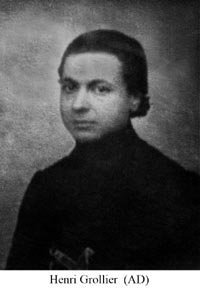Born: Montpellier (Hérault), March 30, 1826.
Took the habit: N.-D. de l’Osier, October 12, 1847.
Vows: N.-D. de l’Osier, October 15, 1848.
Priestly ordination: Marseille, June 29, 1851.
Died: Fort Good Hope, Canada, June 4, 1864.
Pierre Henri Grollier was born in Montpellier, France, on March 30, 1826. His parents were Jean-Jacques Grollier, a baker, and Rose Giniès. He was a student of philosophy in his native city when he heard a talk given by Father Léonard Baveaux. He began his novitiate in Notre-Dame de l’Osier o October 12, 1847 and took his vows on October 15 1848. The general council had admitted him to vows on the preceding October 2 with the following comment: “he is an ordinary candidate from the point of view of both talent and piety and tends to form particular friendships”. He did his scholasticate studies in the seminary of Marseille. Father Jean Marchal, moderator of scholastics, wrote in his report: “I have known Brother Grollier for four years. He is always punctual and devoted to his duties. He seems pious, with a deep faith and very impressionable in all his conduct. His character is somewhat tender and effeminate. He likes to remain hidden and unnoticed. He becomes attached to little things and tends to be naturally affectionate. His conversations and his whole conduct do not show sufficient firmness, discretion and maturity. He finds studies difficult and also the experience of answering in class. He has an exaggerated view of the difficulties of ministry. He is troubled about his resistance to temptation and becomes quite upset about this to the extent of fearing for his vocation. He is timid. Nevertheless he is pious, punctual, and his success in class has always been satisfactory to his superiors. They are more satisfied with him than he is with himself. He is put off by the idea of mission in France and asks to be sent to the foreign missions, and that is more out of fear of having to prepare his topics than out of a desire to sacrifice himself in a foreign land.” In spite of this rather negative appreciation, the scholastic was ordained priest by Bishop de Mazenod on June 29, 1851. Animated as he was by an ardent zeal throughout the course of his life, he proved to be altogether different from appearances in his scholasticate. According to Bishop Vital Grandin he was bold and courageous, even excessively so.
The young priest worked for a time at the shrine of Notre-Dame de la Garde in Marseilles (1851-1852) and was ten sent to western Canada. On his arrival in Red River (Saint-Boniface) in 1852, he left in July for the mission of Fort Chipewyan, Alberta (1852-1856). In 1853 he founded the mission of Notre-Dame des Sept Douleurs in Fond-du-Lac, Athabaska among the Caribou Amerindians who he visited (1853-1856, 1858). Summoned to Île-à-la-Crosse, Saskatchewan (1856-1858) he devoted his ministry to the Montagnais. He then became director of the mission at Fort Resolution (1858-1860) and he was the first Catholic priest to visit Fort Providence (1858, 1859). He founded a mission at Grande Île de l’Orignal (Fort Resolution) and, in 1858 at Fort Rae for the Slave Indians. In 1859 he founded a mission at Fort Rae for the Dogrib Amerindians and another mission for the Slaves at Fort Norman. He visited the mission in 1859 and 1860. He even ventured to the Arctic Circle and founded a mission at Fort Good Hope (1859-1864). In 1860 he visited Fort McPherson on Peel River and met the Loucheux tribe for the first time. He also visited the Tchiglit Inuits (1860-1861) and became the first priest to meet with the Inuits of the Northwest Territories.
During” the last years of his life, Father suffered from asthma. He died in Good Hope mission, on June 4, 1864, in the presence of Father Jean Séguin. In a letter to Father Fabre, on June 4, 1864, Bishop Grandin wrote: “Very Reverend Father, this is the first Oblate to die in this far distant country. You see, he died as a worthy Oblate of Mary, in the greatest poverty, without a doctor, without medicines, without even having a drop of milk or a potato to alleviate his suffering. He died while teaching the natives and when his tongue could no longer speak he taught them by his patience and the holiness of his death. Zeal was the virtue of Father Grollier, zeal that, in his case, eclipsed all others. This zeal was so great that it became at times excessive… God is well acquainted with those who work for him; Father Grollier was the man who was needed in the circumstances in which we are. Far from any superior, he made abundant use of presumed permissions and he accomplished tasks which no superior could ever have permitted or even advised. Once they were accomplished they could merit only praise, and we bless the Lord for that…” In his Esquisse sur le Nord-Ouest de l’Amérique, Bishop A. Taché speaks of him as “the first martyr of the apostolate in the Mackenzie vicariate” (Missions OMI, 8, 1969, p.277).
Father Grollier is buried among the Amerindians at Fort Resolution.
Yvon Beaudoin
and Gaston Carrière, o.m.i.

